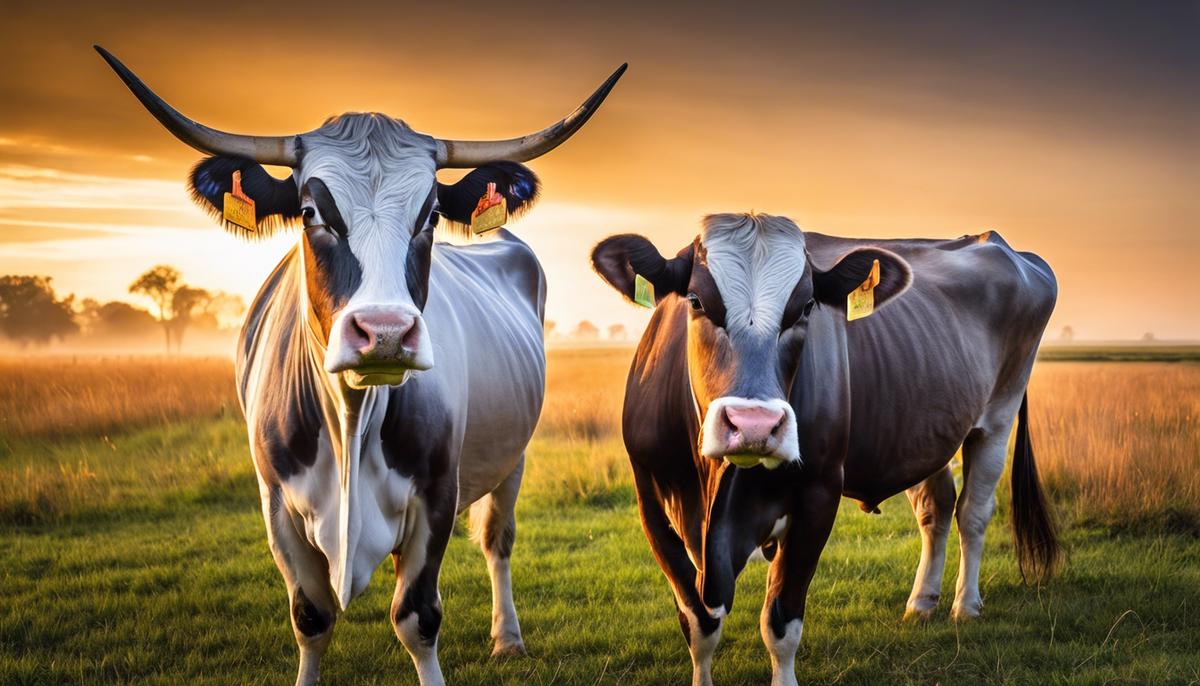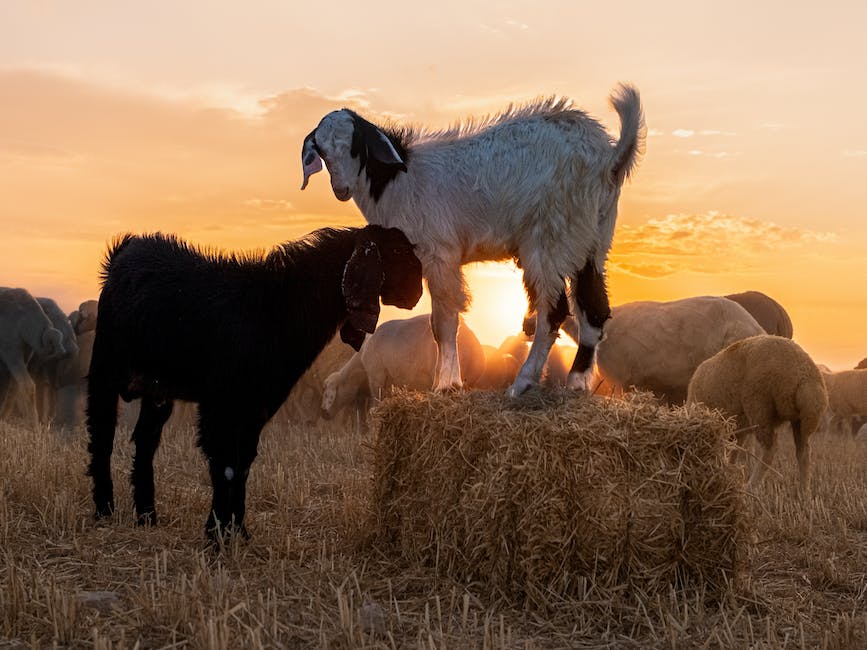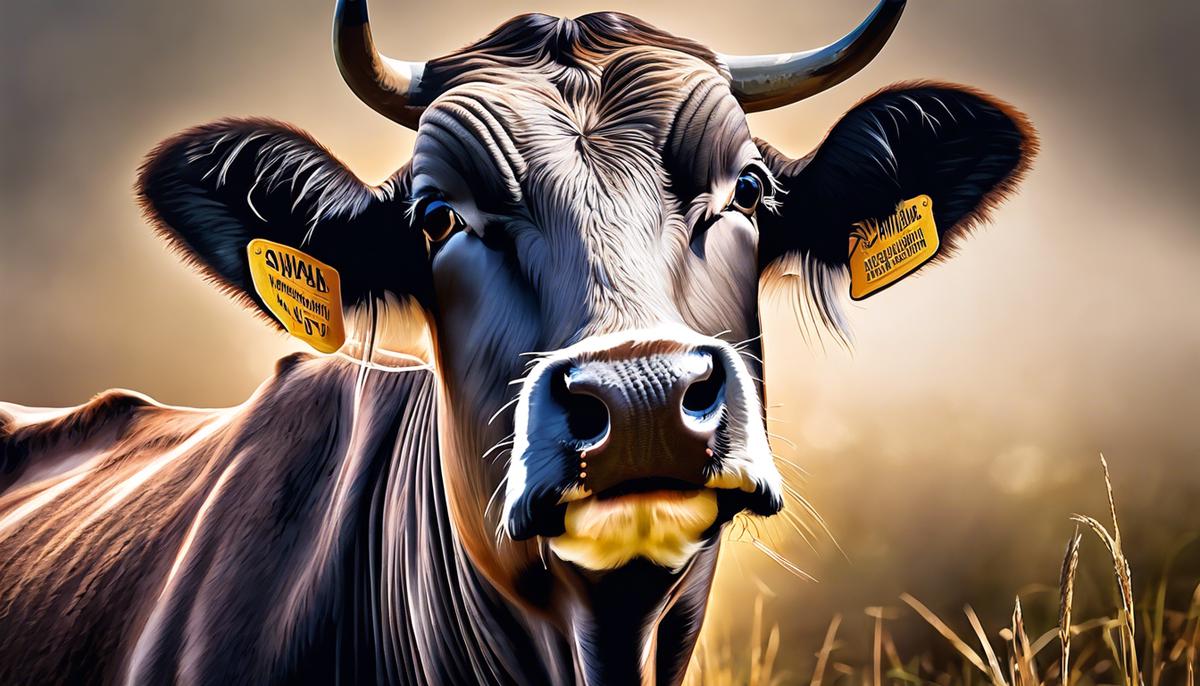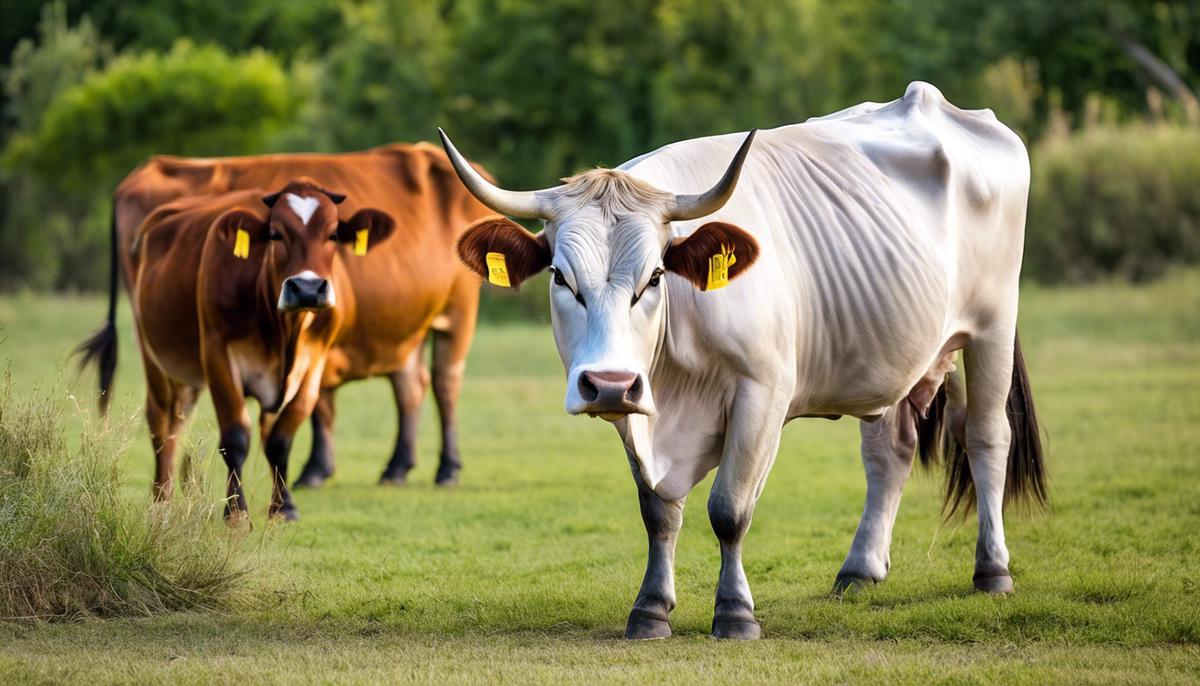

Agridisk
Egypt - Alexandria
.jpeg)
All about american brahman: characteristics and farming
Description: The American Brahman, a breed of beef cattle, boasts a remarkable heritage and an array of physical and genetic traits that render it a cornerstone of American beef production. With unique features such as a large hump, substantial dewlap, and long ears, coupled with a rich skin pigment ideal for tropical and subtropical climates, the American Brahman distinguishes itself as a breed of resilience and adaptability. Beyond its physical characteristics, the breed's far-reaching influence extends into genetics and breeding methods, environmental adaptation, and practical farming practices. This pivotal role has carved out its place within different ecosystems while asserting its economic value. Understanding the American Brahman cattle breed is a venture into the enriched tapestry of bovine history, intertwining resourcefulness, selective breeding, and acclimatization. This unique lineage of cattle, which prides itself as one of the first cattle breeds developed in the United States, has swift roots all the way to India and beyond. The breeding process for the American Brahman began in the early 20th century—the 1900s—though the groundwork for their creation started much earlier. The interest in Indian cattle, specifically the Kankrej, Gujarat, Ongole, and the Gir, emerged because of their adaptability to harsh climates and resistance to parasites. These four strains of Indian cattle collectively formed the basis of what is today recognized as the American Brahman. To traverse back to the point of origin, the first set of Indian cattle was introduced into the United States in 1849. But it was not until the 1900s that selective breeding gradually led to the creation of a new, distinct breed: the American Brahman. The Brahman are the embodiment of the desire to produce a breed that would thrive in the warmer regions of the Southern United States, while also demonstrating breed durability and resilience. The development of the American Brahman breed constitutes a remarkable instance of genetic resource management, with breeders selectively pairing compatible cattle strains to yield desirable traits. This intricate genetic exercise, both painstaking and exciting, led to a breed known for its hardiness, fertility, longevity, and resistance to harsh environmental conditions. The American Brahman cattle have two hallmarks that effortlessly distinguish them from other cattle—their hump and their long, floppy ears. But the striking physical appearance merely serves as a front to the reliable and robust physiology these gentle giants harbor. Their unique ability to withstand heat and resist parasites primarily comes from their dense skin and sleek coat, which efficiently reflect solar radiation. The American Brahman cattle have also revolutionized beef production with their superior meat quality, which has subsequently sparked numerous crossbreeding programs. Crossbreeding Brahmans with other cattle breeds often yields a hybrid vigor, leading to improved beef quality. Today, the American Brahman cattle stand as a testament to the adroitness and foresight of the early cattle breeders. Their presence is globally recognized, influencing beef production in tropical and sub-tropical regions around the world. Named after the Hindu God of creation, “Brahma,” they stand as the epitome of resilience and adaptability, rightly signifying their creation from a broad genetic foundation. Their story is truly a fascinating part of cattle breeding history—a monument to the power of selective breeding and untiring dedication. Delving forward into the tapestry of qualities that characterize the American Brahman cattle breed, it is important to note that while their appearance might be the first striking attribute, there is much more to this breed’s tale, hidden beneath their thick, protective skin. From the heart of their resilience, one can peruse two primary factors: an excellent ability to adapt to diverse environments and an innate ability to effectively use available resources. American Brahman cattle are notably recognized for their exceptional adaptability. As climate and resources fluctuate across geographical planes, these steadfast cattle demonstrate superior sustenance in varying ecological conditions. Whether it's frigid cold, extreme heat, lush highlands, or sparse scrubland, the American Brahman manages it all with an untiring resilience emblematic of their strong genetic lineage. This adaptability is strongly tied to a remarkable physicological capability: the efficient utilization of available feed. Combined with an enhanced metabolic efficiency, American Brahman cattle are known to exhibit a lower feed intake per unit of weight gain as compared to other breeds. This economical trait makes the Brahman an attractive breed of cattle for both small scale farming units as well as extensive cattle ranching operations. Another behavioral facet that figures prominently in the American Brahman's adaptive prowess is their inherent herd structure. These cattle demonstrate sound herd instincts, leading to efficient group behaviors crucial in the context of communal grazing, predator protection, and overall herd health and productivity. Their strong maternal traits, higher fertility, and longevity contribute towards sustainable cattle production units, essential to both farming economy and global food security. As the American Brahman cattle continue to permeate diverse beef industries worldwide, it becomes evident that their story extends beyond sheer physical characteristics. It is the culmination of their physical attributes, coupled with their adaptative and reproductive efficiency, that has cemented their place not only as unique contributors to the global cattle population, but also as living symbols of cattle evolutionary resilience and adaptability. The American Brahman's triumph is thus a testament to the marvels of selective breeding, an ode to the invaluable qualities that they bring to the pasture, and a bright beacon for the future of sustainable cattle farming. A discernable aspect of the American Brahman cattle, not yet highlighted, is the genetic ingenuity that underlies their distinct appearance. It is the specific genetic codes, transmitted from their ancestral Indian cattle strains, that contribute to the breed's hallmark physical features. Embedded in the genome of the Brahman is the genetic 'blueprint' responsible for their distinctive hump and floppy ears. Through the analysis of DNA samples, researchers have been able to trace genetic markers associated with these traits, enhancing our understanding of the breed's unique aesthetic appeal. These genetic revelations have not only informed the cattle breeding process but have also enriched our knowledge of genotypic variations within livestock species. A topic that has raised interest throughout academia is the breed’s distinct adaptability essence. American Brahman cattle possess a unique set of complex genetic traits that equip them with unparalleled resilience. Specifically, inscribed in the DNA of the Brahman are the genes for resisting extreme heat and warding off harmful parasites - traits that have been selected and intensified over several generations of breeding. Furthermore, research has shown that the American Brahman cattle have a genetic predisposition towards effective resource utilization. Their capacity to efficiently process and metabolize feed is a clear-cut example of this attribute. These traits, coded within their DNA, epitomize the evolutionary fitness and metabolic efficiency of this breed. An intriguing aspect to dissect is the herd structure and group behavior patterns exhibited by American Brahman cattle. Meticulous observations have revealed these unique mechanisms to be deeply rooted in their genetic makeup, emphasizing the influence of genetic factors on herd dynamics. Renowned for their strong maternal traits, fertility, and longevity, American Brahman cattle have distinct genetic attributes that set them apart. Through the use of advanced genetic analysis methods, scientists have been able to deduce the genetic factors underpinning these vital reproductive traits, contributing significantly to sustainable cattle production. Looking towards the future, the role of selective breeding cannot be overstated. By utilizing the extensive genetic repository within each Brahman, breeders can create livestock that are not only high in production but also environmentally sustainable. By furthering our understanding of the breed's genetic composition, we can continue to make meaningful strides in harnessing the full potential of the American Brahman cattle. Thus, the genetic factors and breeding techniques that contribute to the distinguishing features and adaptability of American Brahman cattle can be termed a combined triumph of nature and nurture. In conclusion, by marrying the art of selective breeding with the science of genomics, we have unraveled the enigma that is the American Brahman – a testament to the power of genetic influence and technologically-driven selective breeding. An ode to the coming harmony of ancient livestock strains and future of sustainable farming, the American Brahman indeed possesses global significance, stamping an influential footprint on the cattle industry worldwide. Navigating the vast puzzle of genetic codes and traits of the American Brahman cattle can be a fascinating journey. The breed's hallmark physical features, like the pronounced hump and floppy ears, aren’t mere decorative elements. These are incredibly adaptive traits, products of evolutionary processes influenced by genetic markers related to thermo-tolerance and pest resistance. The Brahman's genetic predisposition towards resource utilization is particularly noticeable when analyzing their digestive efficiency. They show an almost uncanny ability to make the most of sparse and low-quality grazing, forestalling the need for extensive additional feed that other cattle breeds might require. It's an impressive facet of their metabolic efficiency that showcases their natural suitability for a wide variety of environments—especially the harsh, low-nutrient landscapes typically found in tropical latitudes. Perhaps one of the more intriguing aspects of Brahman cattle involves patterns of herd structure and group behavior. Observations indicate a notable group cohesion in Brahman herds, combined with a distinctly assertive, alert nature. It is suggested that these behaviors may reflect genetic traits adapted for protection against predators, offering another dimension of the breed's resilience. Consider too, the impressive maternal traits of the American Brahman cow. Famed for their fertility and longevity, these cattle are more inclined to have longer productive life spans. Consequently, they contribute to an overall increase in herd productivity, making them an attractive option for breeders who aim for sustainable cattle production. Technological advances in genetics now allow for a far more detailed exploration of these traits than ever before. The use of advanced genetic analysis methods, such as genotyping and DNA sequencing, have paved the way for a deeper understanding of the breed. By identifying key genetic markers, breeders can make informed decisions to propagate beneficial traits, contributing to even better production outcomes. Ultimately, nature and nurture intermingle in creating the resilient and adaptable American Brahman. It's the combination of inherent genetic factors and expert breeding techniques, that inform the breed’s distinctive traits and capabilities. This balance makes the American Brahman an outstanding exemplar of adaptive traits helping ensure the continuation and progress of sustainable cattle farming. The American Brahman's influence and significance extends far beyond the United States. Given their ability to flourish in diverse climates while maintaining high production levels, this breed has become an important player in the global cattle industry. With their remarkable resilience, adaptability, and efficiency, the American Brahman cattle are bound to remain an invaluable asset in the challenging endeavor of sustainable cattle production. As we continue our quest of understanding and harnessing the full potential of these magnificent cattle, the future of sustainable cattle farming appears promising. Selective breeding, underpinned by in-depth knowledge of genetics, offers a pathway to improved breeds - resilient, productive, and capable of prospering in diverse, challenging environments. Transitioning from a reactive approach to a predictive one, the science of genetics can enable us to preemptively shape a future of robust cattle breeds, with the American Brahman leading the charge. With the vast wealth of information presented, the focus now shifts to the contemporary handling and utilization of American Brahman cattle by farmers across the United States. It must be appreciated that their impressive ability to adapt to a variety of climates and resist diseases makes them a breed of choice for many farmers. Cattle handling is an essential skill for efficient and humane farming practices. Farmers employ a host of strategies to handle Brahman cattle efficiently. These include utilizing the cattle's natural instinct to flock together. For instance, in handling techniques like gathering, holding, and leading, farmers manipulate this herd instinct to control the movement of their cattle. Reward-based learning also forms part of the American Brahman cattle handling techniques. Farmers offer positive reinforcement, delegating the lead role to the more docile individuals, thereby stimulating cooperative behavior within the rest of the herd. This reduces stress, improves herd health, and ultimately enhances productivity. Understanding the breed's behavioral characteristics is also paramount. Farmers recognize that Brahman cattle are known for their intelligence and alertness. They are more reactive to frightening experiences and remember them for longer periods. Hence, they aim to expose them to a variety of experiences while they are still young, so as to help them acclimate better to farming activities. In terms of cattle care, American farmers invest in proper nutrition and health care for their American Brahman herds. A balanced diet plays a key role in the well-being of these cattle. Farmers ensure they provide a diet rich in roughage but also supplement it with protein and energy supplements, particularly during periods of rigorous activities such as calving. Veterinary care is also essential, and while the breed is resilient and has a natural resistance to many common bovine diseases, regular veterinary visits and vaccinations form a part of the routine care. Comprehensive health programs, including routine deworming and vaccination against prevalent diseases, ensure the cattle stay in peak health, effectively maximizing their productivity. An innovative practice that farmers use for American Brahman cattle care and utilization is the use of digital technology. The use of smart collars and ear tags allow farmers to monitor multiple parameters such as feeding patterns, mobility, and estrus detection, thereby ushering a new era of precision farming. Finally, farmers employ American Brahman cattle in sustainable farming practices. Their resilience makes them a preferred option for farmers aiming for environmentally friendly and sustainable farming. Their low methane emissions coupled with their ability to thrive on pasture lands unsuitable for crops, make them an effective component of farming systems striving for carbon neutrality. Thus, American farmers, by adopting a blend of traditional and innovative practices, care for and utilize American Brahman cattle, ensuring they continue to contribute substantially to the nation's beef production industry. The inherent qualities of the breed paired with the dedicated efforts of the farmers pave the way towards a sustainable future for cattle farming. Whether it be their substantial contributions to beef production, their superior adaptability to harsh environments or their substantial economic value, American Brahman cattle have proven to be a significant asset in the farming industry. Challenges notwithstanding, the breed's resilience, genetic versatility, and unique physical traits underscore its indispensability. As we continue to delve into the myriad intricate factors shaping this fascinating breed, the American Brahman's position in the American beef industry remains robust, thus cementing its legacy as a distinctive, versatile and resilient member of the nation's livestock.All about american brahman: characteristics and farming
American Brahman: An Overview
The Rich History and Intriguing Background of the American Brahman Cattle

Physical characteristics of American Brahman

Genetics and Breeding of American Brahman
Unveiling the Genetic Secrets of American Brahman Cattle

Environmental Adaptation and Resilience

American Brahman in Farming Practice
